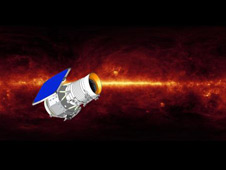NASA's infrared telescopes survey, explain universe

NASA has a couple of cool and extremely cold infrared telescopes: one can pick up objects such as "failed stars" that conventional telescopes would miss and another being built promises to peer deep into space and better explain the origins of the universe.
The WISE telescope or Wide-field Infrared Survey Explorer launched Dec. 14 and just took its first image after ejecting a protective cover. The image shows 3,000 stars in the Carina constellation. As WISE circles the globe, it will take a "freeze frame" every 11 seconds which promises to result in millions of images.

If one image shows 3,000 stars, imagine what millions of images will yield! NASA says it will release the first set of images next month. WISE' mission is to survey the entire sky with the first phase of its mission to be completed in the next six months.
Actually, NASA doesn't call WISE a telescope, but "explorer" sounds a bit vague. Telescope seems right (or camera?).
WISE operates at minus 445 degrees Fahrenheit to eliminate unwanted infrared light that would interfere with the infrared heat it picks in space.
"The WISE mission ends when the frozen hydrogen that keeps the instrument cold evaporates away, an event expected to occur in October 2010. WISE will scan the entire sky for millions of hidden objects, including asteroids, "failed" stars and powerful galaxies. WISE data will serve as navigation charts for other missions such as NASA's Hubble and Spitzer Space Telescopes, pointing them to the most interesting targets WISE finds," according to NASA.
NASA's other big infrared project is the James Webb Space Telescope (JWST - named after a former NASA administrator) that is slated to launch in 2014. While WISE was launched by a NASA Delta II rocket, I would not be surprised if the JWST is hurled into space with one of those commercially-developed SpaceX launch vehicles.
JWST's job is find galaxies that sheds more light on the formation of the universe. On Friday, six of the telescope's 18 beryllium mirrors entered the X-Ray and Cryrogenic Facility at the Marshall Space Flight Center in Huntsville, Ala. where they will be torture tested down to minus 414 degrees Fahrenheit.
These mirrors as NASA likes to say will "look into the past....and tell us about our beginning in the universe and how the first galaxies formed." The Webb Telescope is a joint effort with the Canadian and European space agencies.
Follow meon Twitter.
This post was originally published on Smartplanet.com